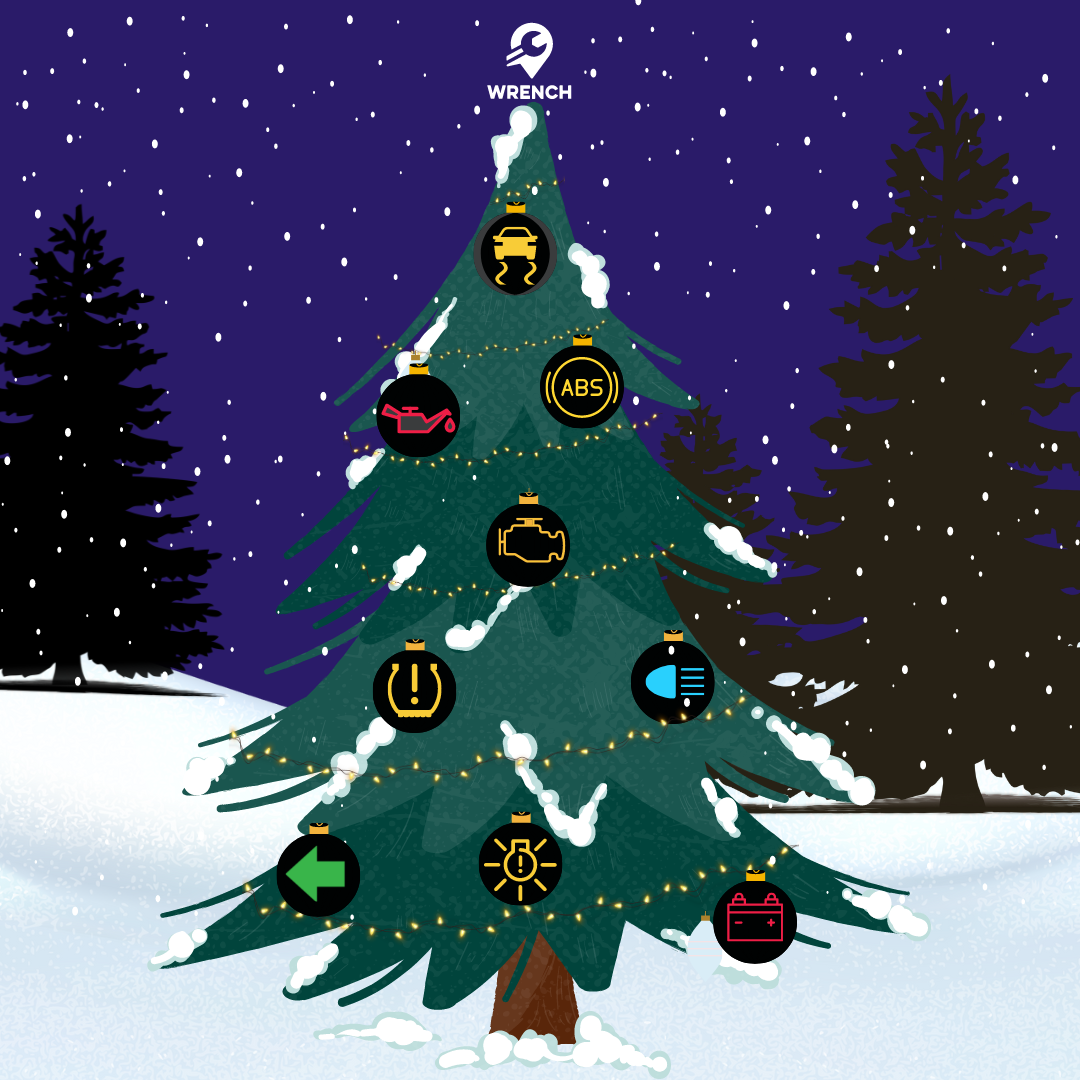It’s Beginning To Look A Lot Like Christmas!
If your town is anything like mine, the wreaths and garlands lining Mainstreet are just the first of many signs that the Christmas season is upon us. Coffee shops selling peppermint mocha, jingle bells accompany every song on the radio, and the profile of every house is traced with lights.
And how about the Christmas trees? These colorful displays are a family favorite.
Get a free quoteIt’s funny though, sometimes a Christmas tree reminds me of my days at the repair shop when one of my rather animated coworkers would use it to describe a vehicle with a lot of warning lights on: “Wow, this instrument cluster is lit up like a Christmas tree!”

If you’ve seen it before, you know that the imagery is very accurate. Instrument clusters in modern vehicles are packed with so many warning lights that it can be difficult to keep track of what they all mean. Even a seasoned technician can occasionally encounter an unknown symbol, especially in a new model year vehicle or unfamiliar vehicle brand.
Instead of trying to tackle them all, I thought it would be best to go over the basics that surprisingly, aren’t well-known to provide a guide to any car owner.
The 3 Distinct Colors Of Severity:
Although there are many lights on a dashboard, they do not all have the same level of importance. Some are considered indicator lights while others are true warning lights. Generally speaking, the color of the illuminated symbol provides insight into the severity of the issue.
- Red naturally communicates a critical warning or safety issue that requires urgent attention. Common examples include the battery light (charging system) and the oil can light (engine oil pressure). Failures in the charging system and engine lubrication system can cause the engine to shut off and not restart, potentially stranding a vehicle in traffic.
- Yellow is the next level down, presenting an alert and recommendation. Common examples include the engine light (check engine) and the tire light (low tire pressure). Problems indicated by these systems may or may not require immediate attention, but warrant further investigation to make that determination.
- Lastly, blue and green are indicator lights that notify the driver of a certain condition. Common examples include the headlight bulb light (high beams) and left/right arrow lights (turn signals). The systems represented by these lights do pose a slight risk to other motorists if used inappropriately, so the indicators serve as a reminder to the driver that they are active.
Trouble Codes May Or May Not Be Stored
Diagnostic Trouble Codes (DTCs) are five-digit codes that can be stored in one or more onboard vehicle computers. Each DTC is unique and identifies a specific type of failure that was detected so that an automotive technician knows where to start testing.
In most cases, a warning light is illuminated because a DTC has been set, however, this is not always the case. The BRAKE indicator light is a great example of this because it can be a sort of indicator/warning light hybrid.
In some cases, it illuminates simply because the parking brake is applied. This condition is not a failure, so there’s no reason for a DTC to be stored, yet it is critical enough to the proper operation of the vehicle that it’s lit up and colored red.
Adding to the complexity of the scenario, the BRAKE indicator light can also come on as a low brake fluid warning, which may or may not set a DTC depending on the vehicle.
Lastly, the BRAKE light could illuminate in conjunction with the closely related anti-lock brake system (ABS) should that system detect a problem.
Multiple Warning Lights Do Not Necessarily Mean Multiple Failures
I’ve talked with enough customers to know that there is an extra amount of anxiety when they are blindsided by multiple warning lights coming on at once. The good news is that this doesn’t necessarily mean that there are multiple problems!
Some systems are very closely related and use many of the same parts. If one of these shared components has a problem, it makes sense that multiple systems would be affected.
Perhaps the best example of this is a faulty wheel speed sensor (WSS). The ABS and Traction Control system must know the speed of a wheel to determine if it is locking up or slipping. When a WSS fails, a wheel speed signal DTC is stored and three warning lights commonly pop on; BRAKE, ABS, and Traction Control.
One Or More Systems May Be Completely Disabled
Building on our WSS failure scenario, it is important to note that something else is taking place in the background; the affected systems are disabled. This might be the most crucial takeaway from this article.
Now, I do need to clarify a bit. If the BRAKE warning is on due to a WSS failure, the brakes aren’t disabled. The hydraulics will still work, however, the ABS light being on indicates that the system will not prevent wheel lockup. This is a safety concern for quick emergency stops, especially during inclement weather or on loose and sandy roads.
Some people might be thinking, “Meh, I’m a good driver. Vehicles didn’t have ABS back when I first started driving. I can do without.” That may be true, but consider this: a driver is not in control of the other vehicles on the road, and collisions are called accidents for a good reason.
Speaking of which, the other system I need to mention here is the supplemental restraint system (SRS). If the SRS light is on, there will not be any airbag deployment should the vehicle be involved in a collision.
But why would engineers design a vehicle this way? I think the logic behind it is that a disabled system is better than a malfunctioning system. In the case of an SRS malfunction, disabled airbags are only a problem if the vehicle wrecks, whereas an inappropriate airbag deployment could be the direct cause of an accident.
A Check Engine Light Discloses More Than You Might Think...
The Check Engine Light (CEL) is by far the most popular warning light of them all. Everybody has likely encountered it at one time or another.
Did you know that it has other names? Over the years and across vehicle manufacturers, this warning light has also been called a Malfunction Indicator Lamp (MIL) and Service Engine Soon (SES) light.
Regardless of what it’s called, there are three interesting and unique conditions that we can know for certain when it illuminates:
First, the CEL indicates that a DTC has been set in the vehicle’s Engine Control Module (ECM). With early diagnostic systems, repair technicians had to jump certain wiring which would cause the CEL to flash in a morse code-like fashion to relay a two-digit code. Thankfully, DTCs can be retrieved more easily today via an onboard diagnostic (OBD) scanner.
Second, the CEL indicates that a failure has been detected that increases emissions. Wait a minute, doesn’t that mean that a DTC could be stored but not cause the CEL to come on? Absolutely! This might be news to even the car-savvy, but that’s how it works for vehicles sold in the United States.
Third, when the CEL is flashing, it indicates a cylinder misfire condition. A misfire damages the vehicle’s catalytic converter (which cleans up the engine’s exhaust emissions), therefore the CEL behavior is modified to help communicate the urgency of the situation.
As may be apparent, the CEL is all about diagnosing, repairing, and protecting the emission system.
In true Christmas fashion, let’s wrap this up and put a bow on it!
The 6 Things A Warning Light Can Indicate:
- The severity of an issue
- A DTC may or may not be stored
- A system is active
- A system is disabled
- Emission levels have increased
- Component damage is imminent
It’s amazing how such a simple warning system can have so much thought and design behind it. I hope that you have found this information helpful, or at the very least, interesting! From my family to yours, have a Merry Christmas and a Happy New Year!
About the Author
Cody Hunt is a Universal Technical Institute (UTI) Graduate, ASE Master Certified Technician, and former Honda Master Technician. He has repaired vehicles in both independent and dealership environments and most recently provided warranty services for Nissan North America before joining the Wrench team. Cody is now providing technical insight for blogs, providing readers with an educated and transparent look into automotive maintenance and repair.


